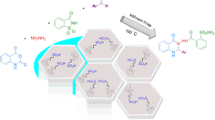Abstract
p-Aminobenzene sulfonamide (sulfanilamide, SN) is the simplest and most-used sulfonamide medicine. The key step of SN production via the commonly used chlorosulfonic acid routine is the synthesis of p-acetaminobenzenesulfonyl chloride (P-ASC). A large amount of HSO3Cl has to be used in the traditional process, which results in serious environmental problems. In this study, an alternative chlorosulfonic acid process to synthesize P-ASC was investigated by partially substituting HSO3Cl by PCl5 as the chlorination agent. Compared with the traditional process, the molar ratio of HSO3Cl to acetanilide (the main raw material) can be decreased from 4.96 to 2.1 using CCl4 as the diluent; also, addition of a small amount of NH4Cl was found to significantly increase the P-ASC yield. Operating conditions of the reaction were studied first by single-factor experiments and later by orthogonal experiments to obtain optimum operating conditions under which the P-ASC yield can reach as high as 86.3 %.
Similar content being viewed by others
References
Boekman, F., Bohman, O., & Siegbahn, H. O. G. (1992). ESCA studies of phase transfer catalysts in solution. 2. Surface ion pairing and salting-out effects. The Journal of Physical Chemistry, 96, 2278–2283. DOI: 10.1021/j100184a047.
Castaner, J., Riera, J., Carilla=., J., Robert, A, Molins, E., & Miravitlles, C. (1991). A new trifluoromethylating agent: synthesis of polychlorinated (trifluoromethyl)benzenes and 1,3-bis(trifluoromethyl)benzenes and conversion into their trichloromethyl counterparts and molecular structure of highly strained polychloro-m-xylenes. The Journal of the Organic Chemistry, 56, 103–110. DOI: 10.1021/jo00001a022.
Emerson, D. W., & Ifalade, S. O. (2005). Improved preparation of macroporous, chlorosulfonated poly(styrene-codivinylbenzene) and conversion to sulfonamides and sulfonylhydrazines. Industrial & Engineering Chemistry Research, 44, 7045–7048. DOI: 10.1021/ie050371u.
Fan, X., Wang, J. G., & Wang, J. P. (2005). Optimum semimicro synthesis of P-aminobenzene sulfonamide. Journal of Luoyang Normal Univiversity, 2, 133–135.
Fidock, D. A., Rosenthal, P. J., Croft, S. L., Brun, R., & Nwaka, S. (2004). Antimalarial drug discovery: efficacy models for compound screening. Nature Reviews Drug Discovery, 3, 509–520. DOI: 10.1038/nrd1416.
Galat, A. (1944). New processes for sulfanilamide. Industrial & Engineering Chemistry, 36, 192. DOI: 10.1021/ie50410a023.
Gao, F., Wang, Y., & Zeng, Y. (2002). New process study on sulfanilamide synthesis by chlorobenzene. Chemical Production and Technology, 9, 4–6.
Huang, Z., Lin, Z., & Huang, J. (2001). A novel kind of antitumour drugs using sulfonamide as parent compound. European Journal of Medicinal Chemistry, 36, 863–872. DOI: 10.1016/S0223-5234(01)80002-7.
Kealey, D., & Haines, P. J. (2002). BIOS instant notes in analytical chemistry. New York, NY, USA: Taylor & Francis.
Kong, X., Teng, Y., & Zhang, T. (1998). Synthesis of pacetamidobenzene sulfone chloride. Journal of Shenyang Institute of Chemical Technology, 12, 117–121.
Li, G., Liu, J., & Li, J. (2007). Improved synthetic technology for the organic dye intermediate: p-acetamidobenzene sulfonyl chloride. Journal of Henan Normal University (Natural Science), 35, 182–184.
Li, P. (2002). Treatment of waste acid in chlorosulfonic acid production process. Chemical Intermediates, 17, 15–16.
Li, Y., & Hu, C. (2005). Experimental design and data analysis. Beijing, China: Chemical Industry Press.
Lin, X., Wei, R.-Q., Liu, X.-N., & Zhou, R. (2009). Study on the function group uniformity of polystyrol sulfonyl chloride resins by infrared spectra. Spectroscopy and Spectral Analysis, 29, 1801–1804. DOI: 10.3964/j.issn.1000-0593(2009)07-1801-04.
Martin, H., Gysin, H., Neracher, O., & Hirt, R. (1943). U.S. Patent No. 243,5974. Washington, D.C.: U.S. Patent and Trademark Office.
Martin. H., & Hirt, R. (1947). U.S. Patent No. 242,9207. Washington, D.C.: U.S. Patent and Trademark Office.
Meier, M., & Tronich, W. (1992). U.S. Patent No. 513,6043. Washington, D.C.: U.S. Patent and Trademark Office.
Meng, G. (1995). Improvement for the synthesis and purification of p-acetate-amino-benzene-sulfonyl chloride. Jounal of Henan Normal University (Medical Science), 14, 179–180.
Montgomery, D. C. (2004). Design and analysis of experiments (6th Ed.). New York, NY, USA: Wiley.
Moore, R. M., Jr. (2003). A convenient synthesis of high-purity 1-chloro-2,6-difluorobenzene. Organic Process Research & Development, 7, 921–924. DOI: 10.1021/op0340816.
Pence, L. H., & Winter, H. C. (1939). Purification of pacetaminobenzenesulfonyl chloride. Journal of the American Chemical Society, 61, 2977–2978. DOI: 10.1021/ja01265a509.
Pouchert, C. J. (1970). The Aldrich library of infrared spectra. Milwaukee, WI, USA: Aldrich Chemical Co Inc.
Smiles, S., & Stewart, J. (1925). p-Acetaminobenzenesulfonyl chloride. Organic Syntheses, 5, 1.
Song, B. (1990). New process for acetanilide chlorosulfonation. Tianjin Chemical Industry, 2, 24–29.
Su, Y., & Hao, Y. (2005). Improved technology for synthesis of p-acetylsulfanilamide. Journal Hebei Normal University (Natural Science Edition), 29, 58–60.
Su, Y., & Yang, J. (2002). Improved technology for synthesis of p-acetamidobenzenesulfonyl chloride. Journal Hebei Normal University (Natural Science Edition), 26, 162–164.
Xin, J.-F., Ma, J.-H., Zhang, S.-F., Chen, S.-R., & Li, H.-Y. (2006). Review of the methods of preparing acyl chlorides. Hebei Chemical Engineering Industry, 29, 16–18.
Zeng, Z. (1981). Organic chemical experiments. Beijing, China: People’s Education Press.
Zhang, S. (1991). Handbook of fine organic chemical technology. Beijing, China: Science Press.
Zhao, Z., Wolkenberg, S. E., Lu, M., Munshi, V., Moyer, G., Feng, M., Carella, A. V., Ecto, L. T., Gabryelski, L. J., Lai, M.-T., Prasad, S. G., Yan, Y., McGaughey, G. B., Miller, M. D., Lindsley, C. W., Hartman, G. D., Vacca, J. P., & Williams, T. M. (2008). Novel indole-3-sulfonamides as potent HIV non-nucleoside reverse transcriptase inhibitors (NNRTIs). Bioorganic & Medicinal Chemistry Letters, 18, 554–559. DOI: 10.1016/j.bmcl.2007.11.085.
Author information
Authors and Affiliations
Corresponding author
Rights and permissions
About this article
Cite this article
Tan, S., Yang, Y., Luo, Z. et al. An alternative synthetic process of p-acetaminobenzenesulfonyl chloride through combined chlorosulfonation by HClSO3 and PCl5 . Chem. Pap. 65, 510–518 (2011). https://doi.org/10.2478/s11696-011-0026-1
Received:
Revised:
Accepted:
Published:
Issue Date:
DOI: https://doi.org/10.2478/s11696-011-0026-1




